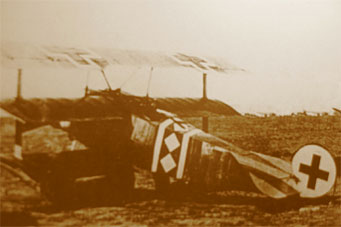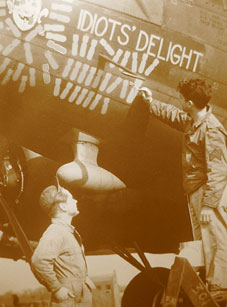|
 The
origin of Nose Art goes back to some ancient time when the first proud
charioteer decorated his vehicle so that it would be distinguishable from
the others. The desire to personalize an object, a machine, to make it unique among the
multitude, is basic to man's nature. Place man under great stresses, give
him a very uncertain future, and this desire can become an obsession. So
it is in war, and with the machines of war. A thousand B-17s, identical in
every way, roll off the assembly line and fly to an uncertain fate, but
each one can be different. The difference is not in the tail number. Those
are for record keepers and ribbon clerks. The difference is in the
imagination and talent of the crew. Few crew members would talk about
247613 or 34356, but many tales would be told about "Sack Time" or "The
Dragon Lady". The
origin of Nose Art goes back to some ancient time when the first proud
charioteer decorated his vehicle so that it would be distinguishable from
the others. The desire to personalize an object, a machine, to make it unique among the
multitude, is basic to man's nature. Place man under great stresses, give
him a very uncertain future, and this desire can become an obsession. So
it is in war, and with the machines of war. A thousand B-17s, identical in
every way, roll off the assembly line and fly to an uncertain fate, but
each one can be different. The difference is not in the tail number. Those
are for record keepers and ribbon clerks. The difference is in the
imagination and talent of the crew. Few crew members would talk about
247613 or 34356, but many tales would be told about "Sack Time" or "The
Dragon Lady".
The ideas for Nose Art
came from everywhere; girlfriends, wives, posters, matchbook covers,
calendars, the comics or some event related to the history of the aircraft.
The "Swamp Angel" landed in a swamp, "Patched Up Piece" had probably been
repaired more than once. "Just Once More" seems like a reasonable request
for a B-17 crew trying to complete twenty-five missions so they could go
home. "SHEDONWANNA?" could relate to problems that the crew had with the
aircraft.
But the majority of
the Nose Art was inspired by the artwork in the magazines and calendars of
the time. Disney characters were prevalent, as well as the comic strips.
But the most widely copied artist was Alberto Vargas.
 The artwork could be
painted on the plane by anyone. Those units fortunate enough to have
talented artists produced excellent Nose Art. Some units went so far as to
recruit artists, while some did without. It all had to do with the place,
the people and the situation. Some of the remote outfits did not have the
paint to do detailed work, while others had all they could ask for. So
Nose Art came in all different shapes and sizes. The small ones could fit
on a card table, while some of the B-29 artwork was bigger than a
billboard. The artwork could be
painted on the plane by anyone. Those units fortunate enough to have
talented artists produced excellent Nose Art. Some units went so far as to
recruit artists, while some did without. It all had to do with the place,
the people and the situation. Some of the remote outfits did not have the
paint to do detailed work, while others had all they could ask for. So
Nose Art came in all different shapes and sizes. The small ones could fit
on a card table, while some of the B-29 artwork was bigger than a
billboard.
There is no question
that the golden age of Nose Art was during World War II and Korea. World
War II was a time during which almost anything was allowed in an effort to
boost morale and unit efficiency. But, as is the case with most things, a
free hand led to some excesses and some censorship is evident in some of
the artwork.
After Korea, Nose Art disappeared from US aircrafts. Artwork reappeared on
a few Vietnam-vintage planes, but then it disappeared again. Nowadays Nose
Art is making a
slowly but surely
comeback.
|